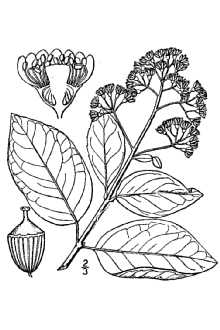
Decumaria, the woodvamps, is a genus of two species of flowering plants in the family Hydrangeaceae, one native to the southeastern United States, and the other native to central China.

Jujube, sometimes jujuba, known by the scientific name Ziziphus jujuba and also called red date, Chinese date, and Chinese jujube, is a species in the genus Ziziphus in the buckthorn family Rhamnaceae. It is often confused with the closely related Indian Jujube, Z. mauritiana. The Chinese jujube enjoys a diverse range of climates from temperate to tropical, whereas the Indian jujube is restricted to warmer subtropical and tropical climates.

The loquat, called biwa in Japan, is a large evergreen shrub or tree grown commercially for its orange fruit and for its leaves, which are used to make herbal tea. It is also cultivated as an ornamental plant.

Theaceae, the tea family, is a family of flowering plants comprising shrubs and trees, including the economically important tea plant, and the ornamental camellias. It can be described as having from seven to 40 genera, depending on the source and the method of circumscription used. The family Ternstroemiaceae has been included within Theaceae; however, the APG III system of 2009 places it instead in Pentaphylacaceae. Most but not all species are native to China and East Asia.
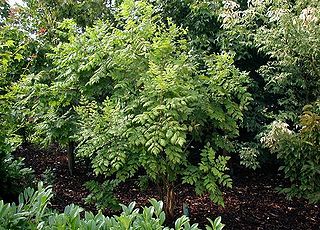
Koelreuteria, also known as chinese lantern tree, is a genus of three species of flowering plants in the family Sapindaceae, native to southern and eastern Asia.
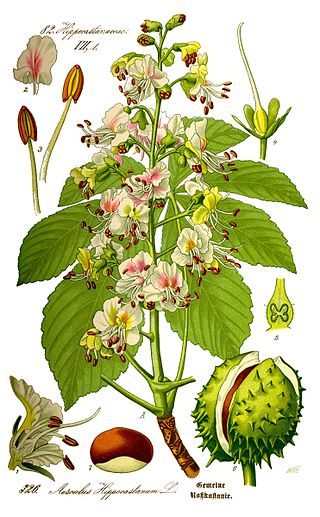
Aesculus hippocastanum, the horse chestnut, is a species of flowering plant in the maple, soapberry and lychee family Sapindaceae. It is a large, deciduous, synoecious (hermaphroditic-flowered) tree. It is also called horse-chestnut, European horsechestnut, buckeye, and conker tree. It is not to be confused with the Spanish chestnut, Castanea sativa, which is a tree in another family, Fagaceae.
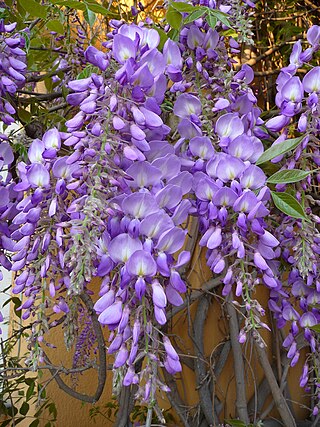
Wisteria sinensis, commonly known as the Chinese wisteria, is a species of flowering plant in the pea family, native to China, in the provinces of Guangxi, Guizhou, Hebei, Henan, Hubei, Shaanxi, and Yunnan. Growing 20–30 m (66–98 ft) tall, it is a deciduous vine. It is widely cultivated in temperate regions for its twisting stems and masses of scented flowers in hanging racemes, in spring.

Staphylea, called bladdernuts, is a small genus of 10 or 11 species of flowering plants in the family Staphyleaceae, native to temperate regions of the Northern Hemisphere. The highest species diversity is in China, where four species occur.
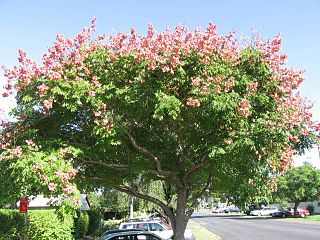
Koelreuteria elegans, more commonly known as flamegold rain tree, is a deciduous tree 15–17 metres tall. There are currently two subspecies under this taxa, i.e., K. elegansssp.elegans, which is endemic to Fiji, and K. elegansssp. formosana, which is endemic to Taiwan. The subspecies formosana, commonly known as Taiwanese golden rain tree, is widely grown throughout the tropics and sub-tropical parts of the world as a street tree.

Catalpa bignonioides is a short-lived species of Catalpa that is native to the southeastern United States in Alabama, Florida, Georgia, Louisiana, and Mississippi. Common names include southern catalpa, cigartree, and Indian-bean-tree. It is commonly used as a garden and street tree.

Calodendrum capense, the Cape chestnut, is an African tree which was first studied at The Cape in South Africa and cultivated widely for its prolific flower display. The tree obtained the common name of "Cape chestnut" because explorer William Burchell saw a resemblance to the horse chestnut in terms of flowers and fruit, though the two are not closely related.
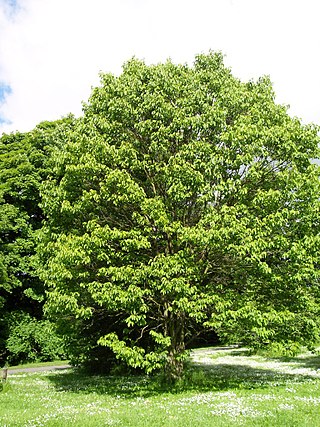
Hovenia dulcis, the Japanese raisin tree or oriental raisin tree, is a hardy tree found in Asia, from Eastern China and Korea to the Himalayas, growing preferably in a sunny position on moist sandy or loamy soils. The tree known for its health benefits when consumed in tea, introduced as an ornamental tree to several countries, also bears edible fruit. It is considered to be one of the most pervasive invaders in Brazilian subtropical forests.

Aphanamixis polystachya, the pithraj tree, is a species of tree in the family Meliaceae. It is native to India, Pakistan, Nepal, Bhutan, Bangladesh, Myanmar and Sri Lanka. It is a widely used as a medicinal plant in Ayurveda.
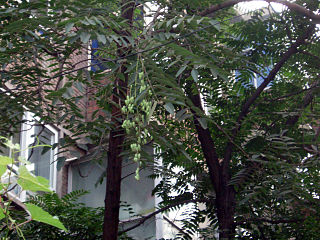
Toona sinensis, commonly called Chinese mahogany, Chinese cedar, Chinese toon, beef and onion plant, or red toon is a species of Toona native to eastern and southeastern Asia, ranging from northern Korean peninsula through most of eastern, central, and southwestern China, in Nepal, northeastern India, Burma (Myanmar), Thailand, and even present in Malaysia and western Indonesia.

Gleditsia sinensis, known as zào jiá (皂荚) or Chinese honey locust and black locust in English, is a species of flowering plant native to Asia.
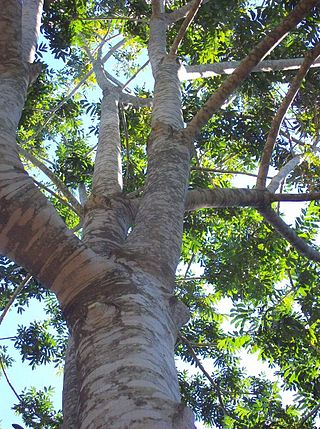
Didymocheton rufus is a rainforest tree in the family Meliaceae, found in eastern Australia. It occurs on a variety of different soils and rainforest types. From as far south as Bulahdelah, New South Wales to the McIlwraith Range in far north eastern Australia. The specific epithet rufus refers to the rusty red of the leaf, fruit and flower hairs of this species.

Populus ciliata, the Himalayan poplar, is a large deciduous tree with tall clean straight trunk and wide rounded crown. The bark of the young trees is smooth greenish-grey and the bark of the old trees is dark brown with vertical cracks. Leaves are broadly ovate with serrulate-crenate and hairy margins. Flowers are drooping raceme catkins appear before or with leaves. Populus ciliata flowers are dioecious, individual flowers are either male or female. Perianth of male flowers is bell-shaped and female flowers are bluntly toothed. Their capsule encloses an average of 100–150 seeds, which are covered by long silky hair.

Aesculus chinensis, the Chinese horse chestnut or Chinese buckeye, is a deciduous temperate tree species in the genus Aesculus found across China. It was first successfully introduced to Britain in 1912 by plant collector William Purdom, who collected six young plants from the grounds of a temple in the western hills of Beijing, and brought them back to Veitch's Nursery in Coombe Hill near London. Purdom's correspondence regarding this event are held in the archives of the Arnold Arboretum. One plant was sent to the Royal Botanic Gardens Kew and two to the Arnold Arboretum in Boston. The original tree at Kew no longer exists but a young tree grafted from the original now grows in the Rhododendron Dell.

Atropanthe is a monotypic genus of flowering plants belonging to tribe Hyoscyameae of subfamily Solanoideae of the family Solanaceae.

Hovenia acerba is a species of flowering plant in the raisin tree genus Hovenia, native to temperate areas of Nepal, the eastern Himalayas, Assam, Myanmar, northern Thailand, Tibet, and central and southern China. A tree reaching 25 m (82 ft), it is found at elevations up to 2,100 m (6,900 ft), in wooded and open areas, forest edges, and slopes, and it is frequently cultivated locally.





























